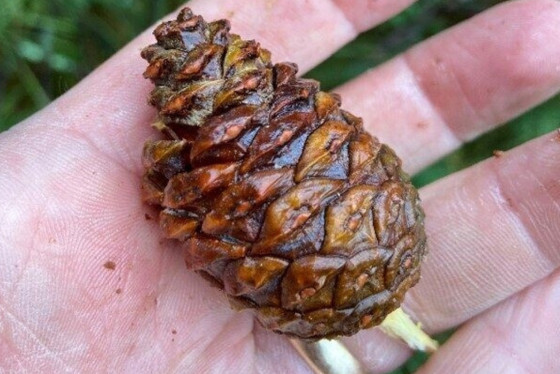Contact: Jeremiah J. Auer, DNR Forest Regeneration Specialist
Jeremiah.Auer@wisconsin.gov or 715-459-1999
DNR Looking To Buy Bushels Of Red And White Pine Cones
 State nurseries pay $125 per bushel of red pine cones and $60 per bushel of white pine cones.
Photo credit: Wisconsin DNR
State nurseries pay $125 per bushel of red pine cones and $60 per bushel of white pine cones.
Photo credit: Wisconsin DNR
MADISON, Wis. – The Wisconsin Department of Natural Resources (DNR) needs your help collecting red and white pine cones for its reforestation program.
“The state nurseries will pay collectors to bring in these cones," said Joseph Vande Hey, Wisconsin DNR forestation team leader at the Wilson State Nursery in Boscobel. "We have a network of seed- and cone-buying stations scattered across the state."
Early September is the prime time to collect mature red and white pine cones, when the color has just turned brown, but the scales have not yet opened to release the seeds.
The state nurseries pay $125 per bushel of red pine cones and $60 per bushel of white pine cones. A bushel is 8 gallons, and experienced collectors can pick a bushel of red pine cones in about 2-3 hours when the cone crop is good. White pine cones are larger, so picking a bushel usually takes about an hour.
How To Collect
- Before collecting cones, contact one of the state nurseries to ensure purchasing is still open.
- Griffith Nursery – Wisconsin Rapids 715-424-3700
- Wilson Nursery – Boscobel 608-375-4123
- Hayward Nursery – Hayward 715-492-1204
- All seeds must be of natural origin. Trees in your yard are not appropriate for seed harvest.
- When mature, the seed within will develop a dark brown seed coat with a papery light brown wing. The perfect time to pick the cones is before the cone opens.
- Wear gloves so your hands don’t get covered in sap.
- Picking is easiest and safest for the collector and the tree when done from the ground using handheld landscaping shears.
- A quick snip leaves a small wound on the tree and a clean cone. Then, a collector just needs to store the cones in a cool, dry area until they can be transported to a seed collection site.
- Do not mistake Austrian or Scotch pine for red or white pine. Scotch pine bark is flaky (especially toward the upper part of the stem) and orange, and its cones appear twisted and green, even at maturity. Austrian pine tends to be found in urban environments, has a stocky appearance and has darker bark. The DNR’s “Forest Trees of Wisconsin” booklet can help collectors identify red and white pines.
How To Sell
- Store the cones in breathable containers in a cool, dry place.
- Deliver the cones to one of the DNR buying stations as soon as possible. If excess debris is mixed in with the cones, they may be rejected, or a price reduction may be applied. The DNR reserves the right to refuse purchase if the cones don’t meet specifications.
View full information on seed sales on the DNR’s Sell Tree Seed webpage.
